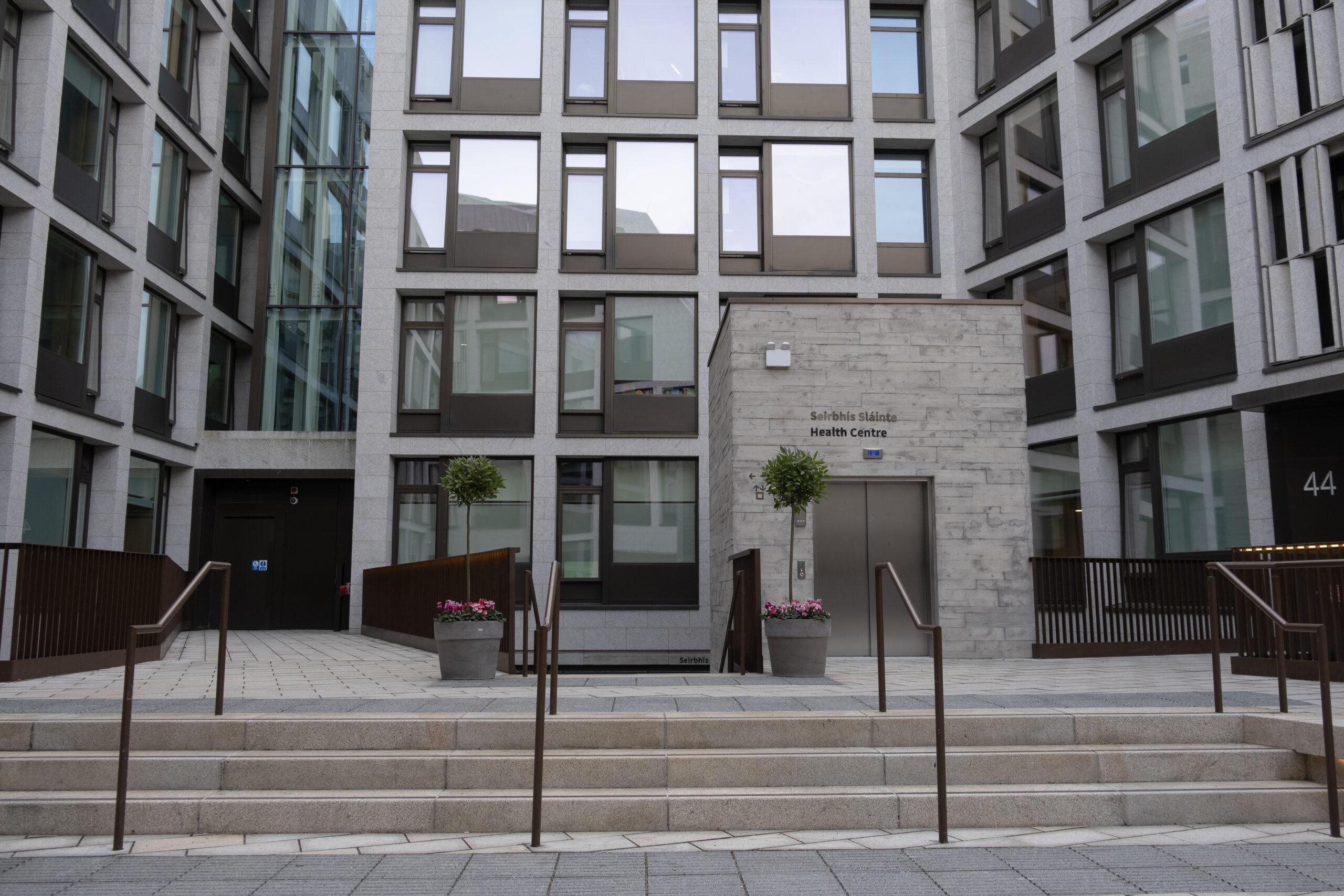On Monday, October 9, 2023, the official launch of Printing House Square took place outside the brand new complex. Tasked with accommodating 249 student bedrooms, the Trinity Health Centre, Trinity DisAbility Hub, and a modern Sports Centre facility, the design team of Printing House Square had a lot on its hands. Trinity News spoke with officials responsible for this “4 birds with one stone” project who revealed how they got it done.
Following ribbon-cuttings in front of each of the four defining features of the new complex, everyone gathered in one of the new Squash Courts for the speeches of Provost Linda Doyle and Project Sponsor and Dean of Students Kevin O’Kelly.
The road may not have been a smooth one, but everyone involved in the building’s construction, including McCullough Mulvin Architects, the architects tasked with the design of the building, seemed proud to finally see this behemoth of a project completed.
While the square is the home of multiple Trinity administrative offices, both Doyle and O’Kelly emphasised that the “primary” function of Printing House is to serve as an accommodation for Trinity students.
Four birds with one stone
“… the plan also needed to include a Health Centre, DisAbility Hub, and Sports Centre”
In its planning stage, the designs for Printing House Square were extensive. Not only was the task to build a space that would accommodate 249 bedrooms, as well as shared living rooms, but also to include a Health Centre, DisAbility Hub, and Sports Centre – long-overdue services previously pushed out by other projects.
Heritage: Constraint and opportunity
The history of Printing House also had to be factored into the architecture of the square, something which Lead Architect Valerie Mulvin saw as both a constraint and an opportunity. For one, Mulvin and her team couldn’t radically renovate the historic building and had to try and conserve as much of its traditional integrity as possible. While this was certainly a challenge, Mulvin saw this as an opportunity from an aesthetic and architectural perspective. In the end, the team created an extension to the already existing Trinity squares, and connected it to the city through a new entrance.
Another problem the team ran into was the strict construction restrictions imposed by Dublin City Council. The original design included an additional floor, but this plan was squashed by the Council. Faced with this limitation, the main concern for Mulvin and O’Kelly was to not lose a single student bed which meant that their solution was lowering the floor of the Health and Sports services. This led to some of the bedrooms creeping into the roof, but allowed for all bedrooms to have access to sunlight.
Responsibility to students
As both Doyle and O’Kelly highlighted, the predominant concern was their responsibility to provide
Valerie Mulvin, lead architect, and Kevin O’Kelly, Project Sponsor at the Official Launch. Photo via Paul Sharp for Trinity News.student accommodation, as well as create a residence that would foster a sense of community and belonging. The creation of clusters of rooms within houses that are each assigned a defining colour were designed to strengthen the sense of living in a house, rather than a “block”. The social character they strived to create was further enhanced by glass walls, separating the common areas, devised to increase the social atmosphere by allowing students to always know when their housemates are home. This decision caused controversy, as it was argued that tourists would not appreciate this voyeuristic feature. But O’Kelly “stuck his foot down”, considering it crucial to prioritise students’ social well-being over potential tourists’ protestations.
Sustainability & accessibility
Some of the main aspects factoring into the building of Printing House were sustainability, accessibility, and durability. The building incorporates solar panels, rainwater harvesting and is made out of GGBS concrete, a form of concrete designed to reduce the building’s carbon footprint while increasing its durability. Student Houses are equipped with water metres, measuring the water usage of each House in order to instil a sense of ownership in the students; to nudge them to change their behaviour voluntarily, rather than creating an environment of enforcement and penalties. It goes without saying that these sustainable factors came with corresponding costs. However, O’Kelly emphasised the necessity of thinking about the durability of the building, stressing that “what you build now, you’re going to live with”.
Battle between commercial vs students
Currently, the most pressing issue students are faced with across Ireland is the housing crisis and the difficulty of finding both affordable and livable student accommodation. Thus, another primary objective for the Square was to avoid a tiered system of prices between the varying Trinity student accommodations. When asked how this factored into the making of Printing House, O’Kelly argued that their a dominant concern was to take such financial pressure off of students, and to find varying ways to accomplish this while still being able to finance the new building. One way this is being done is by renting out the accommodation to tourists and conferences during the summer months. This consideration is evident in the construction of en-suite bedrooms, which not only serve students but also contribute to the comfort of tourists, cross-subsidising the cost of the investment.
A viable solution?
“… the additional 249 rooms, while helpful, do not sufficiently address the acute need for affordable Student Accommodation”
Amidst the lack of funding for Third Education and the Housing Crisis, there has rarely been a more urgent need for student accommodation and welfare services. Printing House Square seems, at least from a sustainability point of view, like a durable investment. However, as many students have pointed out, the additional 249 rooms, while helpful, do not sufficiently address the acute need for affordable student accommodation. Printing House Square is certainly a step in the right direction but we need to keep walking.

Ribbon-cutting in Printing House Square at the Official Launch. Photo via Paul Sharp for Trinity News.






